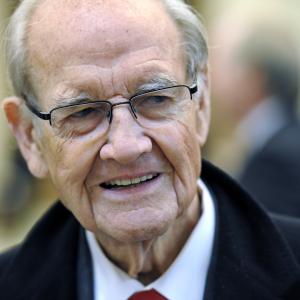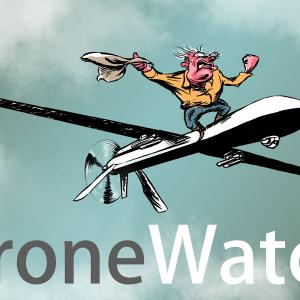
Duane Shank was Associate Editor for Sojourners magazine and was on the staff from 1995 to 2014.
Duane has been active as an organizer and administrator in the peace and justice movement for 35 years, beginning as a draft resistance and antiwar organizer during the Vietnam war. He has worked as a community organizer in the rural south, in interfaith coalitions, and in the nuclear weapons freeze and Central America solidarity movements of the 1980s. His positions have included Associate for the National Inter-religious Service Board for Conscientious Objectors; National Coordinator for the Committee Against Registration and the Draft; Deputy Director and Acting Executive Director for SANE/Freeze; and Research Fellow for the Institute for Policy Studies.
Duane attended Eastern Mennonite University. He is a Anabaptist/Mennonite, and currently an active member and serves on the worship leadership team of the Community of Christ ecumenical congregation in the Mt. Pleasant neighborhood of Washington, D.C. His views on faith and politics have been shaped by (among others), John Howard Yoder, Abraham Joshua Heschel, Martin Luther King, Jr., Dietrich Bonhoeffer, and Oscar Romero.
Duane is married to Ellen Kennel. They have a daughter, Celeste, a graduate of Goshen College, IN, the Medill School of Journalism at Northwestern University, and the University of Chicago Divinity School.
In addition to family, church, and work; his passions are baseball (Washington Nationals), blues (Buddy Guy and Stevie Ray Vaughan) and bluegrass music (Ralph Stanley), and barbecue.
Posts By This Author
George McGovern, 1922-2012
Former Senator and presidential candidate George McGovern died early Sunday morning at a hospice in Sioux Falls, S.D. He had been suffering from a number of conditions related to age, and was admitted to the hospice earlier this week. In a statement announcing his death, his family said:
“We are blessed to know that our father lived a long, successful and productive life advocating for the hungry, being a progressive voice for millions and fighting for peace."
DRONE WATCH: CIA Wants More Drones.
The Washington Post reports this morning that the CIA wants more drones.
“The CIA is urging the White House to approve a significant expansion of the agency’s fleet of armed drones, a move that would extend the spy service’s decade-long transformation into a paramilitary force, U.S. officials said.
“The proposal by CIA Director David H. Petraeus would bolster the agency’s ability to sustain its campaigns of lethal strikes in Pakistan and Yemen and enable it, if directed, to shift aircraft to emerging al-Qaeda threats in North Africa or other trouble spots, officials said.
Malala Yousafzai Recovering
Malala Yousafzai, the teenage girl who was shot by Taliban gunmen in Pakistan for her activism, is recovering at a hospital in Britain. The Guardian reported this morning
“Malala Yousafzai, the teenage girl flown to Britain for treatment after being shot in the head by Taliban gunmen in Pakistan, has the potential to make "pretty much a full recovery", her doctors have said.
“She is able to stand with help and is writing notes, and although the bullet grazed her brain she has not shown "any deficit in terms of function", doctors at Queen Elizabeth hospital in Birmingham said on Friday. She was "not out of the woods but is doing very well", said Dr. Dave Rosser, medical director of the University Hospitals Birmingham NHS foundation trust.”
The shooting has attracted a mass outpouring of support, both in Pakistan around the world. And Yousafzai is apparently aware of that support. According to Dr. Rosser
"She is keen that people share the details. She is also keen that I thank people for their support and their interest. She is obviously aware of the amount of support and interest this has generated around the world. She is keen to thank people for that."
DRONE WATCH: Continuing Controversy Over Drone Shot Down By Israel
Nearly two weeks ago, Israeli jets shot down a drone that had crossed into its airspace. For several days, there was speculation that it had been launched by Hezbollah, speculation that Prime Minister Netanyahu turned into an accusation.
Last Thursday, Reuters reported a confirmation
“Lebanese Hezbollah leader Sayyed Hassan Nasrallah acknowledged on Thursday sending a drone aircraft that was shot down last weekend after flying some 25 miles into Israel. Nasrallah said in a televised speech that the drone's parts were manufactured in Iran and it was assembled by members of the Shi'ite Muslim militant movement in Lebanon.”
Iran then acknowledged that the drone had been manufactured in that country and assembled in Lebanon. The purpose of the flight over Israel was seen as monitoring and gathering intelligence on Israel’s nuclear research center. McClatchy News reports
“This was a crude device, but it was a drone with all the capabilities that unmanned aerial crafts offer, and for that reason it is worrying,” an Israeli military official told McClatchy under the condition that he not be identified because he was not authorized to discuss sensitive information with a reporter. “We are studying the drone now to learn more about what it accomplished and what Hezbollah intended with it.”
Today, Haaretz reports on the continuing situation, now involving the U.N.
“United Nations Secretary General Ban Ki-moon submitted an especially harsh report on the situation in Lebanon, including sharp criticism of Hezbollah, to the 15-member Security Council on Thursday. The report, a copy of which was attained by Haaretz, warned that the Iranian drone launched into Israel by the organization earlier this month was a “reckless provocation” which could lead to a regional conflict.”
As the rhetoric rises, the chances of a greater conflict grow.
DRONE WATCH: Opposition to Drones in Yemen.
Christopher Swift, adjunct professor of national security studies at Georgetown University, traveled to Yemen this summer to interview 40 Yemeni tribal and religious leaders about the increasing U.S. drone attacks on that country. He found that the Yemeni public does not support the attacks. According to National Defense magazine, in a recent panel discussion at Georgetown, Swift said
“There is currently a shift in Yemen from drone attacks that target a particular individual to attacks that are “based upon generalize patterns of what we believe are militant characteristics and militant behavior," he said. Swift advocated a decrease in these “signature strikes,” saying they add to Yemeni concerns about civilian casualties and the United States impeding on their nation’s sovereignty.”
A report this morning by Reuters came to the same conclusion:
“Yemen's interim president has won U.S. praise for cooperating in a war on al Qaeda, but his recent public support for drone strikes that sometimes kill civilians could undermine his domestic popularity and stir sympathy for militants. ... Yemenis complain the U.S. focus on militants is a violation of sovereignty that is driving many towards al Qaeda and diverting attention from other pressing issues such as unemployment, corruption, water depletion and economic revival.”
DRONE WATCH: Nine Deaths in Yemen.
A U.S. drone attack early Thursday morning killed nine suspected militants. Reuters reports:
"Nine suspected al Qaeda militants were killed in what a security source and residents said was a U.S. drone attack on a farmhouse outside a town in southern Yemen that was held by militants last year.
"The farmhouse just west of Jaar, one of two southern towns that Yemen's army took back from rebel control this summer, was hit by three separate missile strikes at dawn, they said.
"The residents said they found six charred bodies and the scattered remains of three other people, including Nader al-Shaddadi, a senior al Qaeda militant in the southern Abyan province who led the group that occupied Jaar."
In the Stacks, October 17, 2012
Among my must reads are the Sunday New York Times Book Review and other book reviews I come across in various media outlets. There are too many books being published that I would love to read, but just don’t have the time. So, I rely on reading book reviews as one way of keeping in touch with what’s being written.
Here are my picks from this week’s books.
DRONE WATCH: The Legal Battle Against Drone Strikes.
Notre Dame law professor Mary Ellen O'Connell, Professor at the University of Notre Dame Law School, has been fighting against drones since the first CIA drone strike in 2002. The Los Angeles Times has a story calling her “a fierce critic of America's drone attacks outside a war zone,” and writing about her insistence that the targeted killings are illegal under international law.
"We wouldn't accept or want a world in which Russia or China or Iran is claiming authority to kill alleged enemies of the state based on secret evidence of the executive branch alone," O'Connell said. "And yet that's the authority we're asserting."
DRONE WATCH: Strikes Resume in Pakistan
Last weekend, the government of Pakistan prevented an anti-drone protest from entering the tribal regions. Led by former cricket star and now politician Imran Khan and including a delegation of 30 US activists, the caravan was blocked by barricades guarded by riot police.
The Guardian reported:
“Makeshift roadblocks, security threats and warnings from Pakistan's army forced Imran Khan to abandon his unprecedented attempt to lead a cavalcade of anti-drone protesters deep into the country's restive tribal belt on Sunday. Leading a convoy of thousands, the former cricketer was within striking distance of South Waziristan, where the CIA uses remote-controlled planes in the fight against Islamist militants, when he abruptly turned back.
“Later Khan said he had changed plan because of warnings from the army and the risk of becoming stuck after the military-imposed curfew. Addressing an impromptu rally of his supporters, he said the convoy had still been a huge success because he had gone to areas his political rivals "can only look at on maps." "We want to give a message to America that the more you carry out drone attacks, the more people will hate you," Khan told the crowd of around 2,500 supporters.”
On Wednesday, the drone strikes resumed. BBC reported
“A US drone strike targeting a militant base has killed five insurgents in a Pakistani tribal region near the Afghan border, security officials say. … "Several US drones flew into the area before dawn and fired four missiles on a compound, killing five militants," a security official told the AFP news agency after the strike in Hurmuz area, east of Miranshah, the capital of North Waziristan.”
Thursday, another major strike in which Pakistani newspaper Dawn reported 16 people were killed.
“A US drone attack killed 16 suspected militants and injured six others in the Orakzai agency of Pakistan’s tribal region on Thursday. Four missiles were fired in the Buland Khel area of the Orakzai agency, which is close to the borders of the North and South Waziristan tribal regions in Fata.”
The Associated Press added that according to a government administrator, as many as 12 others were injured and that “Drones were still flying over the site of the attack and locals were reportedly staying away from the site.”
Young Pakistani Activist for Girls' Education Shot by Taliban
One thing that characterized Afghanistan under Taliban rule before 2001 was their treatment of women and girls. From a society of total repression, new expressions of education, culture and human rights have slowly evolved. As you might suspect, Taliban groups in both Afghanistan and Pakistan are not pleased with that development.
On Tuesday, Malala Yusufzai, a 14-year-old education rights activist, was shot and seriously injured on her way home from school in the Swat Valley region of northwest Pakistan. The New York Times, using local news sources, reported on her injuries
"Pakistan’s Express Tribune reported that doctors at a hospital in Mingora, the region’s main city, said that Malala was “out of danger” because the bullet that “struck her skull and came out on the other side and hit her shoulder” had not damaged her brain. The newspaper added that the girl was later moved to Peshawar in a Pakistani Army helicopter.
"But The News, a Pakistani daily, reported late Tuesday that a bullet is still lodged in her head and arrangements were being made by the government to transport Malala abroad for emergency surgery that could not be performed at the military hospital in Peshawar. The newspaper Dawn also reported that surgeons at the military facility said “she immediately needs a sophisticated surgical procedure, which is not possible in the country” to save her life."
The Taliban is unrepentant. According to Al Jazeera,
"The Tehreek-e-Taliban Pakistan (TTP) has since claimed responsibility for the attack.
"Taliban spokesman Ehsanullah Ehsan told the AFP news agency that the group carried out the attack after repeatedly warning Malala to stop speaking out against them.
"She is a Western-minded girl. She always speaks against us. We will target anyone who speaks against the Taliban," he said by telephone from an undisclosed location. "We warned her several times to stop speaking against the Taliban and to stop supporting Western NGOs, and to come to the path of Islam."
One of the challenges facing the U.S. withdrawal of troops is how to provide security for those courageous activists for women’s and girl’s rights and advancement. In a recent study, “Afghan Women Speak,” David Cortright and Kristen Wall at the Kroc Institute for International Peace Studies propose that
“Demilitarization and negotiation of a peace agreement should be coupled with the deployment of an interim peacekeeping force under the auspices of the United Nations to provide transitional security protection for civilians.”
Something along those lines must be created, or we will be reading more stories of advocates being attacked.
In the Stacks, October 9, 2012
Among my must reads are the Sunday New York Times Book Review and other book reviews I come across in various media outlets. There are too many books being published that I would love to read, but just don’t have the time. So, I rely on reading book reviews as one way of keeping in touch with what’s being written.
Here are my picks of this week’s books.
A Commitment to Find Common Ground
Thomas P. O’Neill III, son of Thomas “Tip” O’Neill, former Speaker of the House of Representatives, reminds us of the relationship between his father and former President Ronald Reagan. After describing some of the bruising political battles between the two, he writes:
“Historic tax reforms, seven tax increases, a strong united front that brought down the Soviet Union — all came of a commitment to find common ground. While neither man embraced the other’s worldview, each respected the other’s right to hold it. Each respected the other as a man.
“President Reagan knew my father treasured Boston College, so he was the centerpiece of a dinner at the Washington Hilton Hotel that raised $1 million to build the O’Neill Library there. When Reagan was shot at that same hotel, my father went to his hospital room to pray by his bed.
“No, my father and Reagan weren’t close friends. Famously, after 6 p.m. on quite a few work days, they would sit down for drinks at the White House. But it wasn’t the drinks or the conversation that allowed American government to work. Instead, it was a stubborn refusal not to allow fund-raisers, activists, party platforms or ideological chasms to stand between them and actions — tempered and improved by compromise — that kept this country moving.”
DRONE WATCH: This Week in Drones.
• During the week, reported drone strikes killed 3 in Pakistan on Monday and 5 in Yemen on Thursday.
• A group of U.S. activists is in Pakistan this week protesting the drone attacks. Medea Benjamin of Code Pink writes of the reasons for the trip, Robert Naiman of Just Foreign Policy describes a meeting with Acting U.S. Ambassador to Pakistan Richard Hoagland. The group is planning to join Imran Khan, a charismatic Pakistani politician campaigning to become prime minister, in a march Sunday into South Waziristan to protest drones. The News International in Pakistan reported that Amb. Hoagland told the group there would be no drone strikes n Waziristan during their presence there.
• In Pakistan, DAWN reported on a Wall St. Journal story about the CIA drone program. Once a month, the CIA sends a fax to a Pakistani general outlining the places where it might conduct drone strikes. The Pakistanis do not respond, which the CIA takes as tacit consent to the strikes, and then cites as legal justification for them.
• Ahmed Wali Mujeeb reported for BBC on a trip to Pakistan's tribal region of Waziristan, site of most drone attacks. Noteworthy was his description of the psychological impact on local people; fear, stress, and depression caused by the constant presence of drones hovering in the sky.
• The Christian Science Monitor wonders if drone warfare makes us safer, and takes a look at the top three dangers of drone warfare to America
• In the UK, The Methodist Church, the United Reformed Church and the Baptist Union of Great Britain have written to Foreign Secretary William Hague, expressing their concern over the humanitarian and legal implications of the US drone campaign and urging him to distance the UK government from it.
Can Any Good Come From Drones?
As an antidote to all the stories of killing by drone, I’ve been collecting stories of the good things unpiloted aircraft can potentially do, or are already doing. Many are tasks now being carried out by piloted airplanes and helicopters, but drones bring advantages. They can fly higher, can stay in the air longer, and can fly in more dangerous terrain or situations with no risk to pilots.
Here are 10 things.
1. Monitoring crop watering. “A researcher from Ohio State University envisions the day — less than a decade from now — when a farmer waters the crops then launches an unmanned aerial vehicle to monitor precisely where the water went.” (Dayton Daily News)
2. Acting as lifeguards for beaches. “Surf Life Saving Australia says unmanned aerial drones will patrol some Queensland beaches this summer. … the drones, which have a wingspan of one metre, use cameras to search for swimmers in distress. … the drones will be fitted with flotation buoys that can be dropped down to the ocean.” (Australian Broadcasting Corporation)
3. Monitoring endangered species. “For the past few months, drones have been flying over the tropical forests of south-east Asia to map endangered species. A dozen of these unmanned aircraft, fitted with a video camera and an autopilot, have been deployed and will be joined by several more.” (Guardian)
U.S. Preparing Potential Targets in Libya Attack
The New York Times is reporting this afternoon that secret “target packages” are being prepared by the U.S. for potential action against militants suspected in last week’s attack on the consulate in Benghazi, Libya.
“The American military’s top-secret Joint Special Operations Command is preparing detailed information that could be used to kill or capture some of the militants suspected in the attack last month in Libya that killed Ambassador J. Christopher Stevens and three other Americans, senior military and counterterrorism officials said on Tuesday.
“Preparing the “target packages” is the first step in a process that the Pentagon and Central Intelligence Agency are taking in preparation for, and in advance of, any orders from President Obama and his top civilian and military advisers to carry out action against those determined complicit in the attack on the United States Mission in the eastern Libyan city of Benghazi.
…
“Mr. Obama has a range of options available — including drone strikes, Special Operations raids like the one that killed Osama bin Laden; and joint missions with the Libyan authorities — but all carry substantial political, diplomatic and physical risks.”
A Resurgent Anti-nuclear Weapons Movement
Ken Butigan writes on Waging Nonviolence about the emergence of a new anti-nuclear weapons movement. The Washington Post recently reported that the U.S. government is planning to refurbish its nuclear weapons complex over the next 10 years at a cost of $352 million. In response, writes Butigan:
“So we are in the midst of the next phase of the movement for nuclear disarmament, where a series of campaigns across the U.S. are pumping life into the seven-decade struggle. … For those of us who first came to political activism by tackling the nuclear arms race in the early 1980s, the announcement that the U.S. is online to refurbish and reassert its nuclear might far into the future has a glumly déjà vu feel. At the same time, we know the power of people power movements to change history. Together we can build on this emerging next phase to take action, to stoke alternatives and to prompt a powerful nationwide debate…”
DRONE WATCH: Yemen President Approves Drone Strikes
In a speech last week at the Woodrow Wilson Center in Washington, Yemen’s president Abed Rabbo Mansour Hadiexpressed his support for U.S. drone strikes in that country. According to the New York Times,
“They pinpoint the target and have zero margin of error, if you know what target you’re aiming at,” said Mr. Hadi, a former army officer and the successor to Ali Abdullah Saleh, who stepped down after protests against his three-decade rule.
The United States “helped with their drones because the Yemeni Air Force cannot carry out missions at night,” he said. “The electronic brain’s precision is unmatched by the human brain.”
In an interview with reporters and editors from the Washington Post, Hadi said that he personally approves all drone strikes in Yemen. According to the piece:
“Every operation, before taking place, they take permission from the president,” Hadi said in an interview with reporters and editors from The Washington Post in his hotel suite in the District. …
“Hadi’s comments mark the first time he has publicly acknowledged his direct role in a campaign of strikes by U.S. drones and conventional aircraft targeting an al-Qaeda franchise that is seen as the most potent terrorist threat to the United States.”
DRONE WATCH: Living Under Drones
Researchers at Stanford University and New York University law schools released a major study on the U.S. use of drones in Pakistan, commissioned by a London-based human rights group Reprieve. The study, Living Under Drones, took nine months to complete, including two trips to Pakistan and more than 130 interviews with victims, witnesses and experts. The Bureau of Investigative Journalism is cited in the report for “the best currently available public aggregate data on drone strikes.”
The four major conclusions of the study, highlighted in its executive summary, are:
“First, while civilian casualties are rarely acknowledged by the US government, there is significant evidence that US drone strikes have injured and killed civilians.
“Second, US drone strike policies cause considerable and under-accounted-for harm to the daily lives of ordinary civilians, beyond death and physical injury. Drones hover twenty-four hours a day over communities in northwest Pakistan, striking homes, vehicles, and public spaces without warning. Their presence terrorizes men, women, and children, giving rise to anxiety and psychological trauma among civilian communities.
“Third, publicly available evidence that the strikes have made the US safer overall is ambiguous at best. The strikes have certainly killed alleged combatants and disrupted armed actor networks. However, serious concerns about the efficacy and counter-productive nature of drone strikes have been raised. The number of “high-level” targets killed as a percentage of total casualties is extremely low—estimated at just 2%.
“Fourth, current US targeted killings and drone strike practices undermine respect for the rule of law and international legal protections and may set dangerous precedents. This report casts doubt on the legality of strikes on individuals or groups not linked to the terrorist attacks of September 11, 2011, and who do not pose imminent threats to the US.”
You can read the entire report, along with data, victim’s stories, and resources.
News stories on the study include BBC, Guardian, Chicago Tribune/Los Angeles Times, and CNN.
DRONE WATCH: Five Dead in Pakistan Attack
In the second attack in three days, a drone attack late Monday in northwest Pakistan killed five militants, including two linked to al Qaeda. DAWN reports
“Two key al Qaeda linked operatives, including an operational commander have been killed in Monday’s US drone strike in North Wazirsitan Agency, official sources said.
“The al Qaeda linked militants killed in the drone strike have been identified as Abu Kasha Al-Iraqi and Saleh Al-Turki, an intelligence source told Dawn.Com.
“Abu Kasha Al-Iraqi, hailing from Iraq, had arrived in North Waziristan Agency in 2001 and had since been one of the key operational commanders of the al Qaeda in North Waziristan tribal region, intelligence officials said.”
The Associated Press and Agence France Presse carried earlier reports of the story, before the identifications were made.
DRONE WATCH: Attack Kills 3 in Pakistan.
Al Jazeera reports:
“At least three people have been killed in a suspected US drone attack in Pakistan's northwestern region along the Afghan border, according to a Pakistani security official.
“The target of Saturday’s attack was a vehicle in Dattakhel area in North Waziristan, one of seven tribal districts and hotbed of al-Qaeda-linked fighters. All three people travelling in the car were killed and the vehicle completely destroyed, the security official said on condition of anonymity.”
The attack was also reported in Pakistani newspapers DAWN and The Nation.














